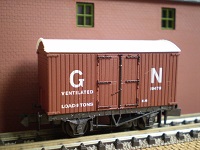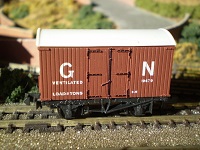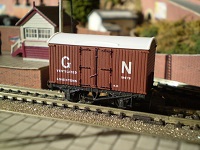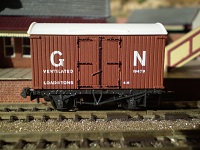The Great Northern Railway was brought into being by an Act of Parliament in 1846, at the height of the speculative frenzy which would later become known as 'Railway Mania'. The aim was to construct a main line connecting London with the burgeoning towns & cities of Yorkshire, an ambitious undertaking by anyone's standards. But the following year the investment bubble burst, and finance for railway projects became ever harder to come by. The new company had to settle for constructing its masterplan piece by piece, and temporarily filling in the gaps by buying running rights over other companies' lines. Gradually the jigsaw came together, with the new London terminus at King's Cross opening in 1852, and by 1860 the network was connected through to Leeds and Bradford as well as up to York. The GNR then entered into the East Coast Joint Stock Agreement with the North Eastern Railway and the North British Railway, and direct trains began to run between King's Cross and Edinburgh. By the 1870s the company was making money hand over fist, and although the express passenger services got the publicity it was the goods traffic which made most of the profits.
Coal from the pits of Yorkshire and Nottinghamshire going south to London made up the majority of the GNR's goods traffic, with the coal carried in the wooden-bodied open wagons synonymous with the industry. But not everything can be carried in a coal truck, and the GNR carried manufactured goods of every description. These needed protecting from the weather whilst en route, not to mention protecting from pilfering by any light-fingered individuals who might fancy helping themselves to some free samples, and they needed to be safely stowed in covered vans. The GNR had a vast fleet of wooden-bodied vans for the purpose, painted up in a drab reddish-brown and lettered with the company's initials. These would have been seen everywhere on the GNR system, from London up to Yorkshire, and would also have travelled on through services to locations on other companies' lines. So they could and would have been encountered pretty much anywhere on the British railway network.
The Great Northern Railway served its customers well for three-quarters of a century, until in the aftermath of the Great War the government of the day forcibly amalgamated all the independent railways into the so-called 'Big Four' regional companies. On the 1st January 1923 the GNR became part of the newly-created London & North Eastern Railway, and a new era began. But the old wagons & vans would have run on for a good few years before the LNER got round to repainting them, and even a century later the old liveries can still be seen on the heritage railways of today. Bring a touch of pre-grouping style to your layout with our Great Northern van.
|









